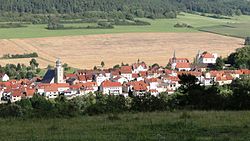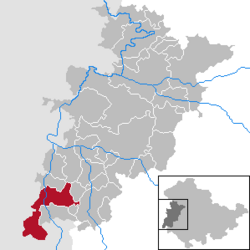Geisa
| Geisa | ||
|---|---|---|
 |
||
|
||
| Coordinates: 50°43′N 09°58′E / 50.717°N 9.967°ECoordinates: 50°43′N 09°58′E / 50.717°N 9.967°E | ||
| Country | Germany | |
| State | Thuringia | |
| District | Wartburgkreis | |
| Government | ||
| • Mayor | Martin Henkel (CDU) | |
| Area | ||
| • Total | 71.75 km2 (27.70 sq mi) | |
| Elevation | 318 m (1,043 ft) | |
| Population (2015-12-31) | ||
| • Total | 4,698 | |
| • Density | 65/km2 (170/sq mi) | |
| Time zone | CET/CEST (UTC+1/+2) | |
| Postal codes | 36419 | |
| Dialling codes | 036967 | |
| Vehicle registration | WAK | |
| Website | www.geisa.de | |
Geisa is a town in the Wartburgkreis district, in Thuringia, Germany. It is situated in the Rhön Mountains, 26 km northeast of Fulda. The near border with Hesse was the border between West Germany and the GDR during the Cold War. Thus, Geisa was in the East German border restriction area of the former inner German border, which meant that until reunification access to the town was limited. The town is the westernmost municipality in what was formerly East Germany.
Geisa is a town in the north of the Rhön Mountains in Thuringia. It is located on the Ulster River. The region is also referred to by the old name of Buchonia. The closest city is Fulda.
Suburbs and their population:
Geisa is mentioned first in a written document in 817 AD as a property of the Benedictine abbey of Fulda. Its oldest area of settlement is located on Gangolfiberg, which is the highest point of the town proper (at 322 m NN). This is also the location of the only surviving medieval place of jurisdiction in Thuringia, the so-called Zentgericht - dating from around the 11th century. A town wall, still largely extant today, was built around the year 1265. The deed of town ordinances and privileges was lost, the first notation as civitas is from 1302.
As an administration centre of the Abbey of Fulda, Geisa was a Catholic-dominated region. Athanasius Kircher was born on 2 May in either 1601 or 1602 in Geisa.
In 1802/03, in the German mediatisation, the ecclesial states including the Bishopric of Fulda were abolished. After the Congress of Vienna, Geisa was a part of the Grand Duchy of Saxe-Weimar-Eisenach until 1918.
...
Wikipedia



